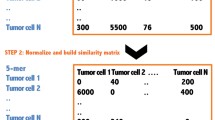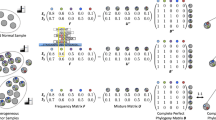Abstract
Recently, Hajirasouliha and Raphael (WABI 2014) proposed a model for deconvoluting mixed tumor samples measured from a collection of high-throughput sequencing reads. This is related to understanding tumor evolution and critical cancer mutations. In short, their formulation asks to split each row of a binary matrix so that the resulting matrix corresponds to a perfect phylogeny and has the minimum number of rows among all matrices with this property. In this paper we disprove several claims about this problem, including an NP-hardness proof of it. However, we show that the problem is indeed NP-hard, by providing a different proof. We also prove NP-completeness of a variant of this problem proposed in the same paper. On the positive side, we obtain a polynomial time algorithm for matrix instances in which no column is contained in both columns of a pair of conflicting columns.
This work was supported in part by the Slovenian Research Agency (I0-0035, research program P1-0285, research projects N1-0032, J1-5433, J1-6720, and J1-6743), by the bilateral project BI-FR/15–16–PROTEUS–003, and by the Academy of Finland, grant 274977.
Access this chapter
Tax calculation will be finalised at checkout
Purchases are for personal use only
Similar content being viewed by others
References
Bafna, V., et al.: A note on efficient computation of haplotypes via perfect phylogeny. J. Comput. Biol. 11(5), 858–866 (2004). http://dx.doi.org/10.1089/cmb.2004.11.858
Campbell, P.J., et al.: Subclonal phylogenetic structures in cancer revealed by ultra-deep sequencing. Proc. Natl. Acad. Sci. 105(35), 13081–13086 (2008). http://dx.doi.org/10.1073/pnas.0801523105
Estabrook, G.F., et al.: An idealized concept of the true cladistic character. Math. Biosci. 23(3–4), 263–272 (1975)
Golumbic, M.C.: Algorithmic Graph Theory and Perfect Graphs. Annals of Discrete Mathematics, vol. 57, 2nd edn. Elsevier Science BV, Amsterdam (2004)
Gusfield, D.: Efficient algorithms for inferring evolutionary trees. Networks 21(1), 19–28 (1991)
Gusfield, D.: Algorithms on Strings, Trees and Sequences: Computer Science and Computational Biology. Cambridge University Press, New York (1997)
Ha, G., et al.: Titan: inference of copy number architectures in clonal cell populations from tumor whole-genome sequence data. Genome Res. 24(11), 1881–1893 (2014). http://genome.cshlp.org/content/24/11/1881.abstract
Hajirasouliha, I., Raphael, B.J.: Reconstructing mutational history in multiply sampled tumors using perfect phylogeny mixtures. In: Brown, D., Morgenstern, B. (eds.) WABI 2014. LNCS, vol. 8701, pp. 354–367. Springer, Heidelberg (2014). http://dx.doi.org/10.1007/978-3-662-44753-6_27
Holyer, I.: The NP-completeness of edge-coloring. SIAM J. Comput. 10(4), 718–720 (1981). http://dx.doi.org/10.1137/0210055
Isaacs, R.: Infinite families of nontrivial trivalent graphs which are not Tait colorable. Amer. Math. Monthly 82, 221–239 (1975)
Jiao, W., et al.: Inferring clonal evolution of tumors from single nucleotide somatic mutations. BMC Bioinform. 15, 35 (2014)
Kačar, U.: Problemi popolne filogenije (Perfect Phylogeny Problems). Final project paper. University of Primorska, Faculty of Mathematics, Natural Sciences and Information Technologies, Koper, Slovenia (2015). http://www.famnit.upr.si/sl/izobrazevanje/zakljucna_dela/view/276
Koboldt, D.C., et al.: VarScan 2: somatic mutation and copy number alteration discovery in cancer by exome sequencing. Genome Res. 22, 568–576 (2012). http://genome.cshlp.org/content/early/2012/02/02/gr.129684.111.abstract
Li, Y., Xie, X.: Mixclone: a mixture model for inferring tumor subclonal populations. BMC Genomics 16(S–2), S1 (2015). http://dx.doi.org/10.1186/1471-2164-16-S2-S1
Miller, C.A., et al.: SciClone: inferring clonal architecture and tracking the spatial and temporal patterns of tumor evolution. PLoS Comput. Biol. 10(8), e1003665+ (2014). http://dx.doi.org/10.1371/journal.pcbi.1003665
Newburger, D.E., et al.: Genome evolution during progression to breast cancer. Genome Res. 23(7), 1097–1108 (2013). http://dx.doi.org/10.1101/gr.151670.112
Nik-Zainal, S., et al.: The life history of 21 breast cancers. Cell 149(5), 994–1007 (2012). http://dx.doi.org/10.1016/j.cell.2012.04.023
Oesper, L., et al.: THetA: inferring intra-tumor heterogeneity from high-throughput DNA sequencing data. Genome Biol. 14(7), R80 (2013). http://dx.doi.org/10.1186/gb-2013-14-7-r80
van Rens, K.E., et al.: SNV-PPILP: refined SNV calling for tumor data using perfect phylogenies and ILP. Bioinformatics 31(7), 1133–1135 (2015). http://bioinformatics.oxfordjournals.org/cgi/content/abstract/btu755?ijkey=XNg7zdRpqjrCkRUI&keytype=ref
Roth, A., et al.: PyClone: statistical inference of clonal population structure in cancer. Nat. Methods 11(4), 396–398 (2014). http://view.ncbi.nlm.nih.gov/pubmed/24633410
Salari, R., et al.: Inference of tumor phylogenies with improved somatic mutation discovery. J. Comput. Biol. 20(11), 933–944 (2013). http://dx.doi.org/10.1089/cmb.2013.0106
Author information
Authors and Affiliations
Corresponding author
Editor information
Editors and Affiliations
Rights and permissions
Copyright information
© 2015 Springer-Verlag Berlin Heidelberg
About this paper
Cite this paper
Hujdurović, A., Kačar, U., Milanič, M., Ries, B., Tomescu, A.I. (2015). Finding a Perfect Phylogeny from Mixed Tumor Samples. In: Pop, M., Touzet, H. (eds) Algorithms in Bioinformatics. WABI 2015. Lecture Notes in Computer Science(), vol 9289. Springer, Berlin, Heidelberg. https://doi.org/10.1007/978-3-662-48221-6_6
Download citation
DOI: https://doi.org/10.1007/978-3-662-48221-6_6
Published:
Publisher Name: Springer, Berlin, Heidelberg
Print ISBN: 978-3-662-48220-9
Online ISBN: 978-3-662-48221-6
eBook Packages: Computer ScienceComputer Science (R0)




